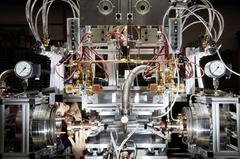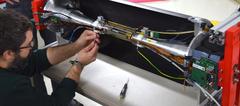URL: https://www.desy.de/news/news_search/index_eng.html
Breadcrumb Navigation
DESY News: Progress on Belle II: magnets in Japan and tests at DESY
News
News from the DESY research centre
Progress on Belle II: magnets in Japan and tests at DESY
The Belle II project at the Japanese research centre KEK is making great strides forward. The detector is being upgraded in international collaboration and must be tested thoroughly before it start taking data with the similarly upgraded SuperKEKB accelerator.

Modern-day “Where’s Wally?”: this vacuum connection system developed at DESY links the beam tube and the high-tech detector (photo: DESY/H. Müller-Elsner).
The Belle II detector will be a great deal more powerful than that its predecessor, Belle. The amount of data will also increase by a factor of 50 as a result of the accelerator upgrade, meaning that physicists will also be able to study extremely rare processes which might shed light on sources of so-called “new physics.”
Increasing the collision rate requires two extremely powerful focussing magnets, which are placed immediately in front of and behind the interaction point, concentrating the particle beams to an extremely narrow region. The first of these two highly complex magnetic systems was already installed at KEK in August 2015. The delivery of the second magnet two weeks ago marks a further important milestone for the project as a whole.
The new and extremely sensitive vertex detector will later be installed between these two magnets. It will be up to the KEK machine group to mount and calibrate the magnets, however DESY is responsible for mapping the detector’s magnetic field, including the stray fields produced by the new focussing magnets. “We need to know the magnetic field and the stray fields very accurately and to use them in reconstructing the particle tracks, if we want to exploit the full precision of Belle II,” explains Carsten Niebuhr, head of the Belle II group at DESY.
DESY also developed the sophisticated vacuum connection system that links the central beam tube, on which the new vertex detector (VXD) will be mounted, to the vacuum system of the focussing magnets. It addresses a particular difficulty: due to the extremely limited space available, these connections must be opened and closed remotely.

Live from the DESY test beamline: a scientist installs new modules in the test rig (photo: Belle II Collab.).
Belle II will specialise in the search for a difference that is subtle but crucial to our own existence: that between matter and antimatter. This difference is the reason why the universe consists almost exclusively of matter, even though one would expect equal amounts of matter and antimatter to have been created at the big bang. In their search for this difference, scientists are concentrating on so-called B mesons, particles consisting of a b quark or b antiquark. It is because of these b quarks that the letter B plays such a key role in antimatter research: Belle II will be conducted using the SuperKEKB accelerator, its predecessor Belle used KEKB, and both the LHCb experiment at CERN and BaBar at SLAC in the United States also have the B in their names.
The Belle II collaboration consists of some 750 scientists from 101 institutions in 23 countries. Germany’s group of research scientists from twelve institutions is the second largest, after Japan’s, and has played a leading role in the development and construction of the vertex detector. The PXD will be assembled over the coming months at the semiconductor laboratory and the Max Plank Institute for Physics in Munich. It will then be thoroughly tested at DESY for three months, before eventually being shipped to Japan in early 2018.
When the Belle II detector goes into full-scale operation at the start of 2019, it will generate huge amounts of data, which will need to be stored, reconstructed and analysed. DESY and GridKa in Karlsruhe are to contribute significant storage and computing resources to the experiment for this purpose.



